1996 TOYOTA TACOMA charging
[x] Cancel search: chargingPage 54 of 196
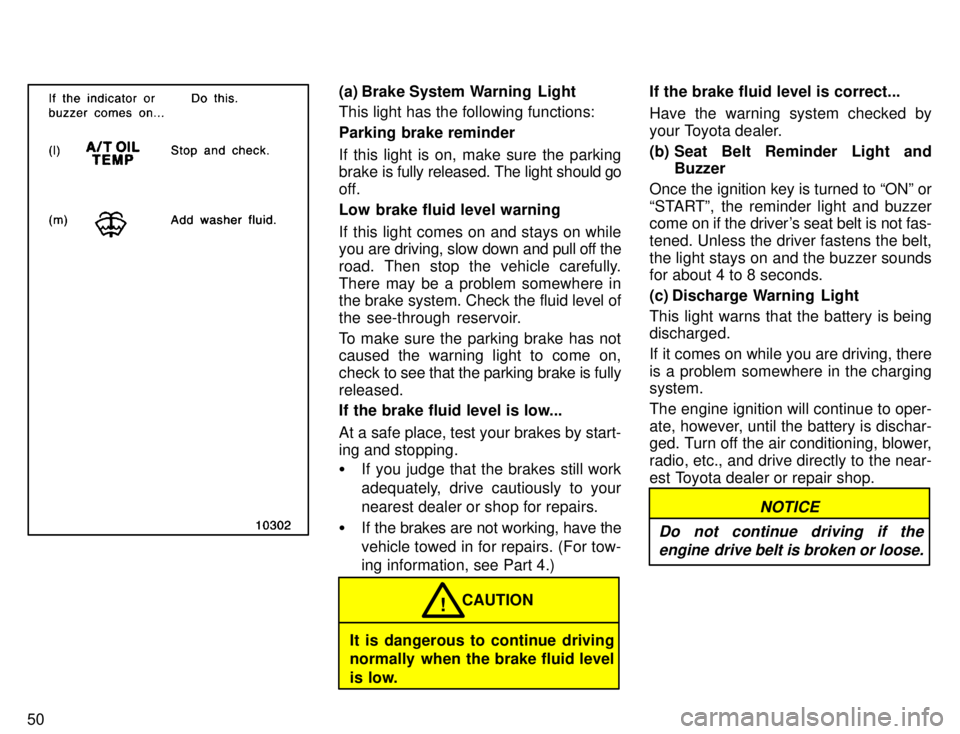
50
(a) Brake System Warning Light This light has the following functions: Parking brake reminder
If this light is on, make sure the parking
brake is fully released. The light should go
off.
Low brake fluid level warning
If this light comes on and stays on while
you are driving, slow down and pull off the
road. Then stop the vehicle carefully.There may be a problem somewhere in
the brake system. Check the fluid level of
the see-through reservoir.
To make sure the parking brake has not
caused the warning light to come on,
check to see that the parking brake is fully
released.
If the brake fluid level is low...
At a safe place, test your brakes by start-
ing and stopping. � If you judge that the brakes still work
adequately, drive cautiously to yournearest dealer or shop for repairs.
� If the brakes are not working, have the
vehicle towed in for repairs. (For tow- ing information, see Part 4.)
It is dangerous to continue driving
normally when the brake fluid level
is low. CAUTION
! If the brake fluid level is correct...
Have the warning system checked by
your Toyota dealer.
(b) Seat Belt Reminder Light and
Buzzer
Once the ignition key is turned to ONº or
STARTº, the reminder light and buzzer
come on if the driver's seat belt is not fas-
tened. Unless the driver fastens the belt, the light stays on and the buzzer sounds for about 4 to 8 seconds.
(c) Discharge Warning Light
This light warns that the battery is being discharged.
If it comes on while you are driving, there
is a problem somewhere in the charging system.
The engine ignition will continue to oper-
ate, however, until the battery is dischar-
ged. Turn off the air conditioning, blower,
radio, etc., and drive directly to the near-
est Toyota dealer or repair shop.
NOTICE
Do not continue driving if the engine drive belt is broken or loose.
Page 125 of 196
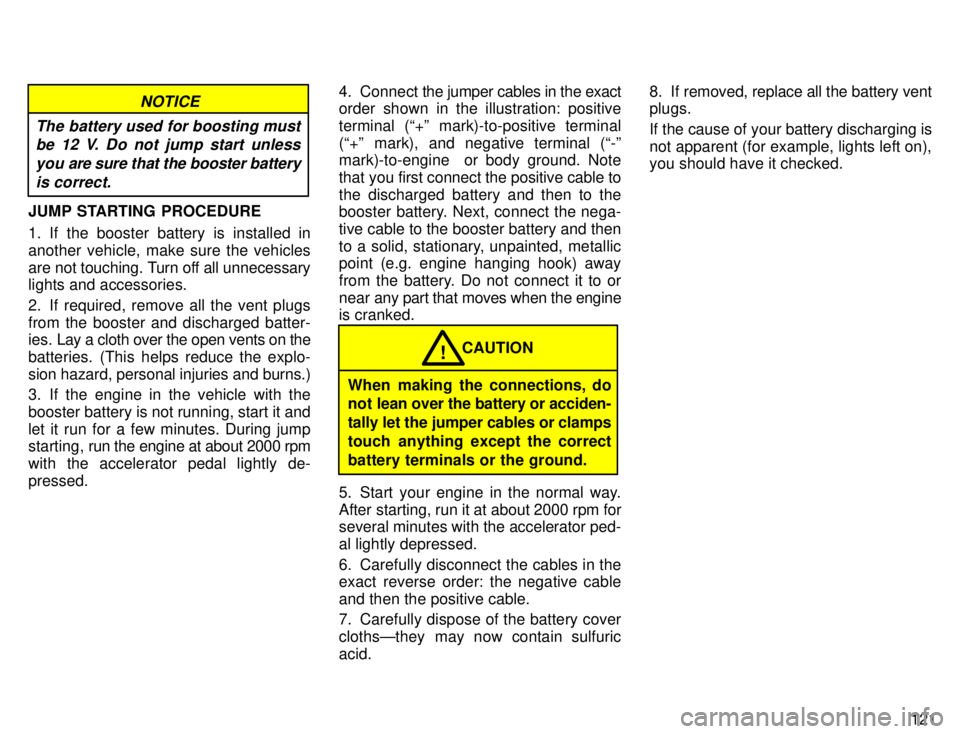
121
NOTICE
The battery used for boosting must be 12 V. Do not jump start unless
you are sure that the booster batteryis correct.
JUMP STARTING PROCEDURE
1. If the booster battery is installed in
another vehicle, make sure the vehicles
are not touching. Turn off all unnecessary
lights and accessories.
2. If required, remove all the vent plugs from the booster and discharged batter- ies. Lay a cloth over the open vents on the
batteries. (This helps reduce the explo-
sion hazard, personal injuries and burns.)
3. If the engine in the vehicle with the booster battery is not running, start it and
let it run for a few minutes. During jump
starting, run the engine at about 2000 rpm
with the accelerator pedal lightly de- pressed. 4. Connect
the jumper cables in the exact
order shown in the illustration: positiveterminal (+º mark)-to-positive terminal
(+º mark), and negative terminal (-º
mark)-to-engine or body ground. Note
that you first connect the positive cable to
the discharged battery and then to the
booster battery. Next, connect the nega-
tive cable to the booster battery and then
to a solid, stationary, unpainted, metallic
point (e.g. engine hanging hook) away
from the battery. Do not connect it to or
near any part that moves when the engine
is cranked.
When making the connections, do
not lean over the battery or acciden- tally let the jumper cables or clamps
touch anything except the correctbattery terminals or the ground. CAUTION
!
5. Start your engine in the normal way.
After starting, run it at about 2000 rpm for several minutes with the accelerator ped-
al lightly depressed.
6. Carefully disconnect the cables in the
exact reverse order: the negative cable
and then the positive cable.
7. Carefully dispose of the battery cover
clothsÐthey may now contain sulfuricacid. 8. If removed, replace all the battery vent plugs.
If the cause of your battery discharging is
not apparent (for example, lights left on), you should have it checked.
Page 169 of 196
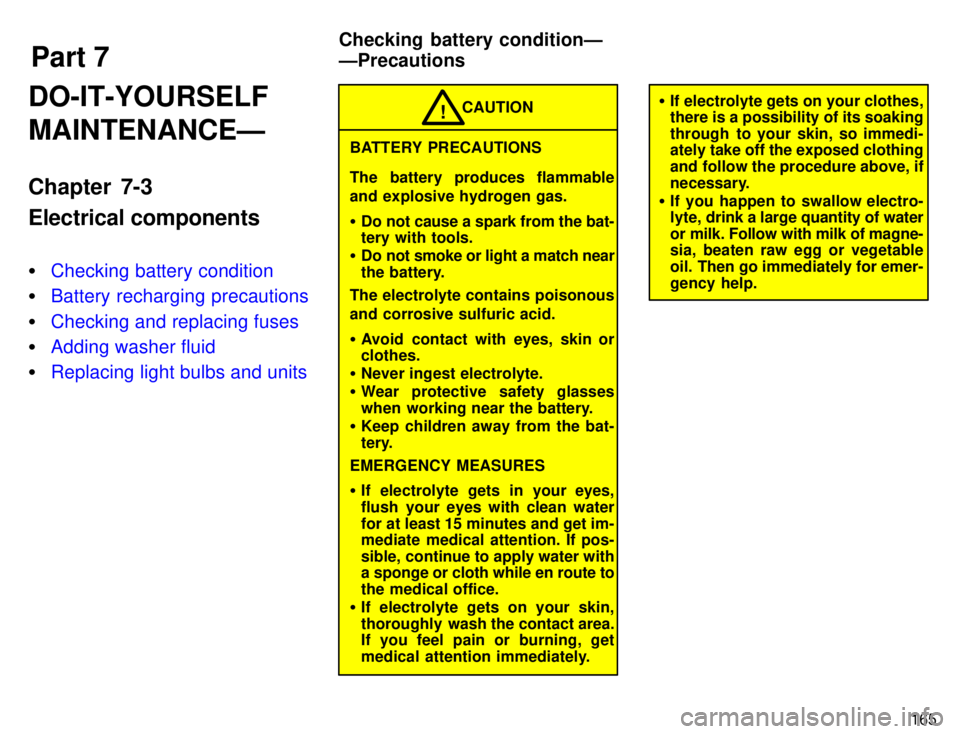
Part 7Checking battery conditionÐ ÐPrecautions
165
DO-IT-YOURSELF MAINTENANCEÐ
Chapter 7-3 Electrical components �
Checking battery condition
�Battery recharging precautions
�Checking and replacing fuses
�Adding washer fluid
�Replacing light bulbs and units
BATTERY PRECAUTIONS
The battery produces flammable
and explosive hydrogen gas. �
Do not cause a spark from the bat-
tery with tools.
� Do not smoke or light a match near
the battery.
The electrolyte contains poisonous
and corrosive sulfuric acid. � Avoid contact with eyes, skin or clothes.
� Never ingest electrolyte.
� Wear protective safety glasses
when working near the battery.
� Keep children away from the bat-
tery.
EMERGENCY MEASURES � If electrolyte gets in your eyes,
flush your eyes with clean water
for at least 15 minutes and get im-
mediate medical attention. If pos-
sible, continue to apply water with
a sponge or cloth while en route to
the medical office.
� If electrolyte gets on your skin,
thoroughly wash the contact area.
If you feel pain or burning, get
medical attention immediately. CAUTION
!�
If electrolyte gets on your clothes,
there is a possibility of its soaking
through to your skin, so immedi- ately take off the exposed clothing
and follow the procedure above, if
necessary.
� If you happen to swallow electro-
lyte, drink a large quantity of water
or milk. Follow with milk of magne-
sia, beaten raw egg or vegetable
oil. Then go immediately for emer-
gency help.
Page 171 of 196
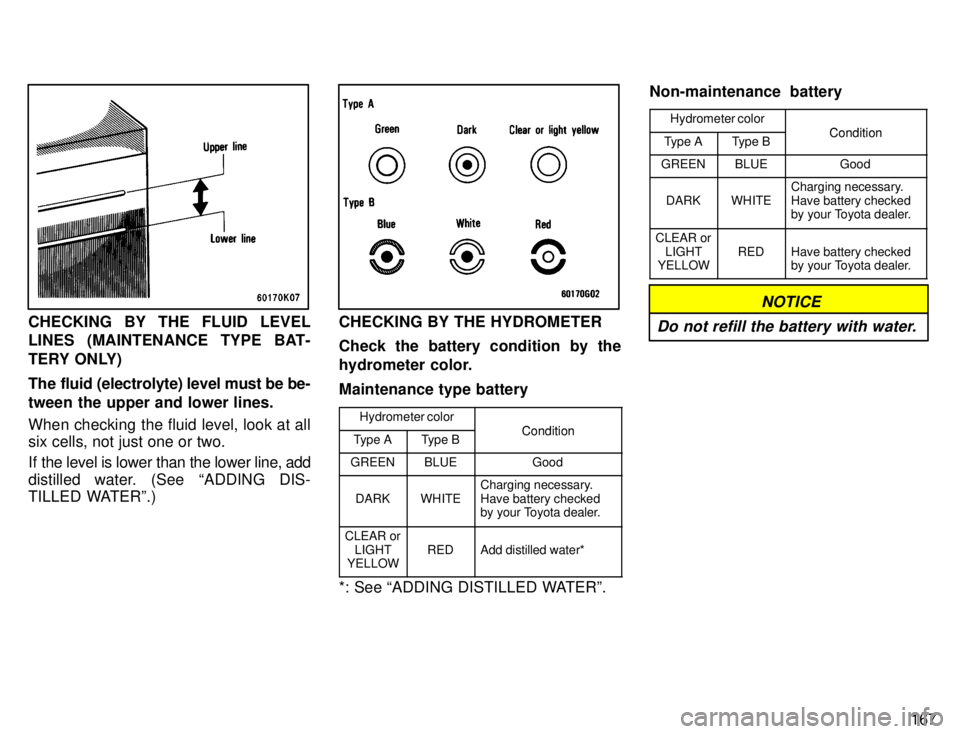
167
CHECKING BY THE FLUID LEVEL
LINES (MAINTENANCE TYPE BAT-
TERY ONLY)
The fluid (electrolyte) level must be be-
tween the upper and lower lines.
When checking the fluid level, look at all six cells, not just one or two.
If the level is lower than the lower line, add
distilled water. (See ADDING DIS-
TILLED WATERº.)CHECKING BY THE HYDROMETER Check the battery condition by the
hydrometer color. Maintenance type batteryHydrometer color
ConditionType AType BCondition
GREENBLUEGood
DARKWHITECharging necessary. Have battery checked
by your Toyota dealer.
CLEAR orLIGHT
YELLOWREDAdd distilled water*
*: See ADDING DISTILLED WATERº. Non-maintenance battery
Hydrometer color
ConditionType AType BCondition
GREENBLUEGood
DARKWHITECharging necessary. Have battery checked
by your Toyota dealer.
CLEAR orLIGHT
YELLOWREDHave battery checked
by your Toyota dealer.
NOTICE
Do not refill the battery with water.
Page 172 of 196
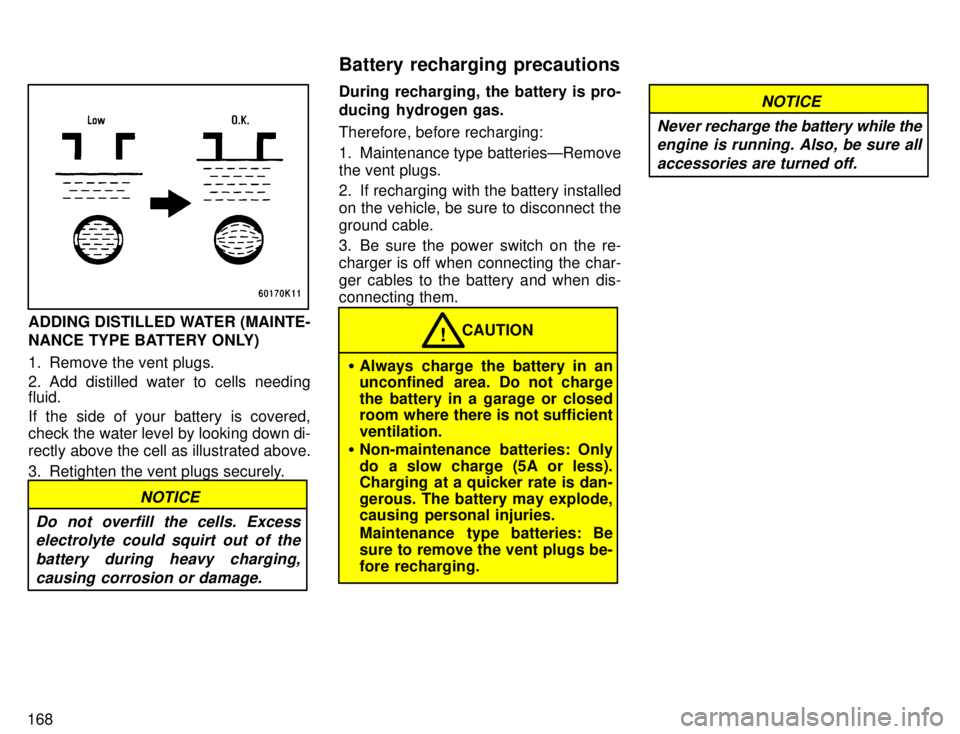
168
ADDING DISTILLED WATER (MAINTE-
NANCE TYPE BATTERY ONLY)
1. Remove the vent plugs.
2. Add distilled water to cells needing fluid.
If the side of your battery is covered,
check the water level by looking down di-
rectly above the cell as illustrated above.
3. Retighten the vent plugs securely.
NOTICE
Do not overfill the cells. Excess electrolyte could squirt out of the
battery during heavy charging,causing corrosion or damage.
During recharging, the battery is pro-
ducing hydrogen gas. Therefore, before recharging:
1. Maintenance type batteriesÐRemove the vent plugs.
2. If recharging with the battery installed on the vehicle, be sure to disconnect theground cable.
3. Be sure the power switch on the re-
charger is off when connecting the char-ger cables to the battery and when dis-
connecting them.
� Always charge the battery in an
unconfined area. Do not charge
the battery in a garage or closed
room where there is not sufficient ventilation.
� Non-maintenance batteries: Only
do a slow charge (5A or less).
Charging at a quicker rate is dan- gerous. The battery may explode,
causing personal injuries.
Maintenance type batteries: Be sure to remove the vent plugs be-fore recharging. CAUTION
!
NOTICE
Never recharge the battery while the
engine is running. Also, be sure all
accessories are turned off.
Battery recharging precautions
Page 184 of 196

180ENGINE LUBRICATION Oil capacity (drain and refill), L (qt., Imp. qt.):
Two-wheel drive models2RZ-FE engine
With filter 5.5 (5.8, 4.8)
Without filter 4.8 (5.0, 4.2)
5VZ-FE engine
With filter 5.4 (5.7, 4.8)
Without filter 5.1 (5.4, 4.5)
Four-wheel drive models
3RZ-FE engineWith filter 5.4 (5.7, 4.8)
Without filter 4.7 (5.0, 4.1)
5VZ-FE engine With filter 5.2 (5.5, 4.6)
Without filter 4.9 (5.2, 4.3)
Oil grade: API SH, Energy-Conserving IIº multi-
grade engine oil or ILSAC multigrade
engine oil is recommended. Recommended oil viscosity (SAE):
COOLING SYSTEM
Total capacity, L (qt., Imp. qt.):
Two-wheel drive models With manual transmission
2RZ-FE engine 8.0 (8.5, 7.0)
5VZ-FE engine
10.1 (10.7, 8.9)
With automatic transmission 2RZ-FE engine
7.8 (8.2, 6.9)
5VZ-FE engine 10.0 (10.5, 8.8) Four-wheel drive models
With manual transmission
3RZ-FE engine 8.3 (8.8, 7.3)
5VZ-FE engine
10.1 (10.7, 8.9)
With automatic transmission 3RZ-FE engine
8.2 (8.7, 7.2)
5VZ-FE engine 10.0 (10.5, 8.8)
Coolant type: With ethylene-glycol antifreeze (Do not use alcohol type.)
BATTERY Open voltage* at 20 �C (68 �F):
12.7 V Fully charged
12.3 V Half charged
11.9 V Discharged
*Voltage that is checked 20 minutes after
the key is removed with all the lights
turned off Charging rates:
5 A max.
Page 187 of 196

183
Engine compartment (U.S.A.) Fuses (type A)
1. STOP 15 A: Stop lights, high-
mounted stoplight, cruise control system
2. ALT-S 7.5 A: Charging system
3. STA 7.5 A: Multiport fuel injection sys-
tem/sequential multiport fuel injection sys-
tem, starting system, gauges and meters
4. OBD 10 A: On-board diagnosis sys-
tem
5. EFI 15 A: Multiport fuel injection sys-
tem/sequential multiport fuel injection system
6. HORN 15 A: Emergency flashers,
horns
P195/75R14 200 (2.0, 29) 240 (2.4, 35) 14 x 5J
P215/70R14 200 (2.0, 29) 200 (2.0, 29) 14 x 6J
14 x 6JJ
P225/75R15 180 (1.8, 26) 200 (2.0, 29) 15 x 6J 15 x 7JJ
31x10.5R15LT 180 (1.8, 26) 200 (2.0, 29) 15 x 7JJ Tire size
Tire pressure
kPa (kgf/cm 2
or bar, psi)
Front RearWheel size
Wheel nut torque, N
�m (kgf �m, ft �lbf):
110 (11.5, 83)
Tires Fuses
Page 188 of 196

184
Engine compartment (Canada)
7. DOME 15 A: Car audio system, power
antenna, interior light, clock, ignition
switch light, personal lights, door courtesy
lights
8. TAIL 10 A: Tail lights, license plate
lights
9. PANEL 10 A: Emergency flashers,
heater control system, air conditioning
cooling system, gauges and meters,
clock, car audio system overdrive indica-
tor light, glovebox light, cigarette lighter,
instrument panel lights
10. A.C 10 A: Air conditioning cooling
system
11. HEAD (RH) 10 A: Right-hand head-
lightInstrument panel
12. HEAD (LH) 10 A: Left-hand head-
light
13. HEAD (HI RH) 10 A: Right-hand
headlight (high beam), hi-beam indicator light
14. HEAD (HI LH) 10 A: Left-hand head-
light (high beam)
15. HEAD (LO RH) 10 A: Right-hand
headlight (low beam)
16. HEAD (LO LH) 10 A: Left-hand
headlight (low beam)
17. DRL 7.5 A: Daytime running light sys-
tem
18. 4WD 15 A: A.D.D. control system,
four-wheel drive control system, rear dif- ferential lock system 19. GAUGE 10 A:
Gauges and meters,
back-up lights, cruise control system,
power antenna, power door lock control
system, electronically controlled automatic
transmission system, starting system,
charging system, heater control system
20. TURN 10 A: Turn signal lights, emer-
gency flashers
21. ECU-IG 15 A: Cruise control system,
anti-lock brake system, shift lock system
22. WIPER 20 A: Windshield wipers and
washer
23. IGN 7.5 A: Discharge warning light,
SRS airbag system
24. RADIO 7.5 A: Car audio system,
power antenna
25. CIG 15 A: Cigarette lighter, clock,
power rear view mirrors, back-up lights,
shift lock system
26. ECU-B 15 A: SRS airbag warning
light, daytime running light system, cruise control system, anti-lock brake system